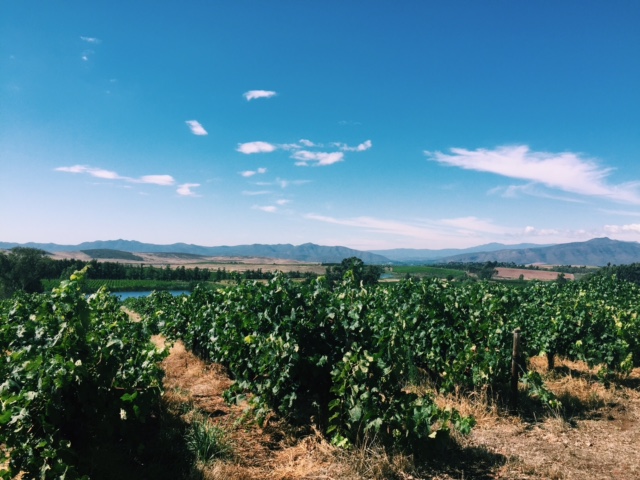Tannat needs a soft touch
You can learn a lot about a farm from the back of a bakkie. A group of us hold onto the moving vehicle’s railings, while winemaker and owner of Kranskop, Newald Marais, shows us around his Robertson estate.
We sway as the bakkie rolls through the vineyards – it’s a bit like being aboard a ship. Piece by piece the farm is slowly revealed. Situated in the Langeberg mountains in the Klaasvoogds wine appellation, we’ve found ourselves pretty high up.
We stop to take it all in: the vines a green sea rippling towards the mountains in the distance. An eagle slices across the sky above, breaking the stillness.
Newald Marais is something of a winemaking legend. Among various other positions, he steered Nederburg’s blends for around 25 years. That’s why he’s decided (for now anyhow) to make single varietal wines.
“It makes a nice change,” he says with a smile. “It’s my new challenge in life to make these individual wines. No single year can be the same – and that intrigues me.”
Though, ironically enough, it was an idea for a blend that resulted in one the most interesting wines in the Breede River Valley: a single varietal Tannat.
“When I planted the Pinot Noir block, I said to myself: ‘I’m taking a risk’. So I decided to plant something that could help with the flavours as well as the colour. I settled on Tannat, as the grape’s strawberry and cherry characteristics would work well with the Pinot Noir as a blending component.
“I’ve never used it in the Pinot Noir.”
So, with all that Tannat going unused, Marais decided to make some wine, of course.
This is a grape with a tricky reputation. The very name conjures up harsh tannins; add to that its natural high acidity. Many a winemaker has lost the battle with this variety.
“The nice thing about Tannat is that it has a low pH [which gives deep colour], coupled with high acidity.”
All of the vineyards on the farm are southeast facing, except for the Tannat site, which is northeast facing. “I planted it in full sun as I knew how high the acidity can get. The cordons are also very low to the ground, so the warmth of the soil, plus the sunlight, helps to breakdown the acids.”
Then, in the cellar, he uses a basket press, and “no pumping”.
“It’s the way you handle the grape that’s the most important, the aim is to get soft tannin – so we don’t use too much new wood, only about 10 to 15 per cent.”
Strangely enough, those strawberry characteristics he was initially after only make an appearance when the wine is fermenting. “The whole cellar smells like strawberries! Though it doesn’t carry to the finished wine, the strawberry disappears as the wine goes dry. The final wine is more spicy, with some red berry fruit and blackberries.”
“How you treat the grapes, that's the secret.”

Kranskop isn’t the first winery to experiment with this temperamental grape (and certainly not the last), though. The first block of Tannat was planted at Klein Amoskuil farm (the then home of Spice Route Winery) in 2003. The Tannat borne of this vineyard is used in the winery’s flagship blend, Chakalaka, as well as occasionally in the Malabar.
“Everyone wants to drink Merlot and Cab but that’s not a good enough reason to plant them,” says Jean-Baptiste Cristini, marketing manager of Spice Route and Fairview.
“Like Petite Sirah and Tempranillo, it’s a variety that’s suited to southern Mediterranean climates. It’s also a late ripener, and relatively resistant to drought and heat.”
At Fairview they make a single-varietal Tannat, from a vineyard planted on the main farm (which dates back to 2004).
When asked about the dilemma that many winemakers face when working with this variety, Cristini muses: “Interestingly, the koffieklip soils [decomposed granite and clay] in Paarl work really well with the grape. It ripens quite evenly with proper canopy management [it’s a very vigourous plant]. In France, the Tannat is this high-tannin, black wine but we’ve found that the granite soils here allow it to become quite elegant.”
Cristini says the nose of the wine reminds him of black stone fruits, “like those dark, rich plums that have just been in season. Then pure, fresh fruit on the palate – but there’s a wildness and savouriness to it.”
And, like Kranskop, they use minimal new wood, as “the older oak really respects the fruit of the variety”.
Glen Carlou is another winery that’s been tempted by Tannat. They produced only 528 bottles for The Curator’s Collection and have since sold out.
“We planted the variety to use mostly for blending,” says marketing manager Georgie Prout. “Varieties like Tannat and Petit Verdot get a bad rap for greenness – mostly in cooler climate regions – but here in the Simonsberg/Paarl region we don’t grow fruit exhibiting the greenness and harshness normally associated with the variety. We get good acids, colour and concentration. So while it may have been used in blending in the past, Arco [Laarman] was inspired in 2010 to release a small-batch wine of Tannat.
“Our Tannat is vibrant red-black in colour with plush, black raspberry on the nose. The flavours that follow are pretty, pure and concentrated, showing dark fruits like cassis and cherries before a wash of tannins reassert control. The lingering finish vibrates between sweet fruit and grippy tannins.”
Something else to look out for: Glen Carlou has made a Tannat Rosé from the 2016 vintage, which will be released later this year.
Has Tannat’s time come? Well, there’s only one way to find out – pour yourself a glass.
– Malu Lambert